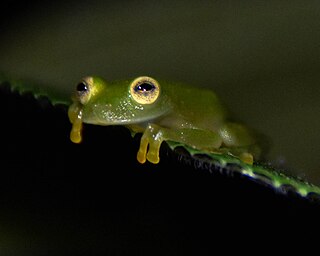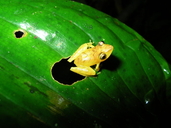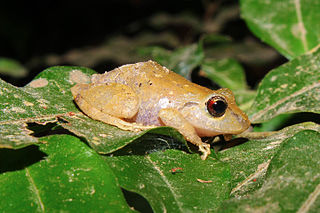
Atelopus chiriquiensis, the Chiriqui harlequin frog or Lewis' stubfoot toad, is an extinct species of toad in the family Bufonidae that was found in the Cordillera de Talamanca in Costa Rica and western Panama. Its natural habitats were stream margins in lower montane wet forests and rainforests. Its elevational range was 1,400–2,500 m (4,600–8,200 ft) asl.
Atelopus senex is an extinct species of toad in the family Bufonidae. It was endemic to Costa Rica and known from the Cordillera Central and Cordillera de Talamanca at elevations of 1,100–2,200 m (3,600–7,200 ft) asl.

Sachatamia ilex is a species of frog in the family Centrolenidae. It is found in eastern Nicaragua, Costa Rica, Panama, western Colombia, and western Ecuador. Common name Limon giant glass frog has been coined for this species, apparently in reference to its type locality in the canton of Limón, Costa Rica, and it is also known as the ghost glass frog.

Cochranella euknemos, sometimes known as the San Jose Cochran frog, is a species of frog in the family Centrolenidae. It is found in central Costa Rica and south/eastward to Panama and to the western flank of the Cordillera Occidental in Colombia. Some Colombian records might apply to Cochranella mache.

Hyalinobatrachium chirripoi is a species of frog in the family Centrolenidae. It is found in extreme northern Ecuador, northwestern Colombia, Panama, and Costa Rica, as well as in Honduras. The specific name chirripoi refers to the Chirripó Indians inhabiting the area of the type locality, Suretka in the Talamanca canton of Costa Rica. Common name Suretka glass frog has been coined for it.

Allobates talamancae is a species of frog in the family Aromobatidae. It is found in northwestern Ecuador, western Colombia, Panama, Costa Rica, and southern Nicaragua.

Dendropsophus phlebodes, the San Carlos treefrog or San Carlos dwarf treefrog, is a species of frog in the family Hylidae. It is found in western Colombia, Costa Rica, Nicaragua and Panama. Its natural habitats are tropical moist lowland forests, but it may also occur in disturbed habitats. It is threatened by habitat loss.
Isthmohyla calypsa is a species of frogs in the family Hylidae. It is known from the southern Cordillera de Talamanca in Costa Rica, Cerro Pando in Costa Rica and Panama, and the Pacific slope in southwestern Panama. It appears to have gone extinct in Costa Rica. Prior to its description in 1996, this species was confused with Isthmohyla lancasteri, a species now known from lower altitudes only.
Isthmohyla debilis is a rare species of frog in the family Hylidae. It occurs in the Atlantic slopes of the Cordillera Central and Cordillera Talamanca in Costa Rica and western Panama as well as on the Pacific slopes in southwestern Panama. Common name Isla Bonita treefrog has been suggested for it.

Isthmohyla rivularis is a rare species of frog in the family Hylidae. It occurs in the cordilleras of Tilarán, Central, and Talamanca in Costa Rica as well as adjacent western Panama. The species was thought to already have become extinct, but in 2007, it was re-discovered in the Monteverde Cloud Forest of Costa Rica when a single male was found. In 2008, a gravid female and few males were spotted. The common name American Cinchona Plantation treefrog has been suggested for it.

Isthmohyla tica, also known as Starrett's treefrog, is a species of frog in the family Hylidae. It is found in the Cordillera de Tilarán, Cordillera Central, and Cordillera de Talamanca of Costa Rica and western Panama. The specific name tica is derived from the name that Costa Ricans use to refer themselves, tico.
Isthmohyla xanthosticta is a species of frogs in the family Hylidae. It is endemic to Costa Rica and only known from its type locality on the south slope of Volcan Barba in the Heredia Province. Common name south fork treefrog has been coined for it.
Isthmohyla zeteki is a species of frogs in the family Hylidae native to the Cordillera Central and Cordillera de Talamanca of Costa Rica and western Panama. The specific name zeteki honors James Zetek, an American entomologist who worked in Panama. Common name Zetek's treefrog has been coined for the species.

Scinax elaeochroa, commonly known as the Sipurio snouted treefrog, or olive snouted treefrog, is a species of frog in the family Hylidae. It is found in the Caribbean lowlands of Nicaragua and Panama and in the Pacific lowlands of Costa Rica and Panama, with an isolated population in Colombia.
Craugastor rayo, also known as the Sabana robber frog, is a species of frog in the family Craugastoridae. It is endemic to the Cordillera de Talamanca, Costa Rica.
Craugastor rhyacobatrachus is a species of frogs in the family Craugastoridae. It is found in the Pacific slopes of the Talamanca-Barú Massif of Costa Rica and western Panama. The specific name rhyacobatrachus is derived from Greek batrachos and rhyaco ("torrent"), in reference to the torrential streams that this species inhabits.
Pristimantis altae is a species of rain frog in the family Craugastoridae with a bright coral-coloured groin. It is found in Costa Rica and Panama. It is locally known as sapito de hojarasca. In 2008 the IUCN began calling it the mountain robber frog following Frank and Ramus (1995).

Pristimantis caryophyllaceus is a species of frog in the family Craugastoridae. It is found in Costa Rica and Panama; records from Colombia prior to 2010 refer to Pristimantis educatoris. However, taxonomy of Pristimantis caryophyllaceus and P. educatoris remain unsettled, and many sources continue to report Pristimantis caryophyllaceus from Colombia.

Pristimantis ridens, also known as the pygmy rain frog and the Rio San Juan robber frog, is a species of frog in the family Craugastoridae. It is found in western Colombia, and then through Panama and Costa Rica to Nicaragua and eastern Honduras.
Oedipina alfaroi is a species of salamander in the family Plethodontidae. It is found in the Caribbean versant of eastern Costa Rica and northwestern Panama. It is commonly known as the Limon worm salamander.











